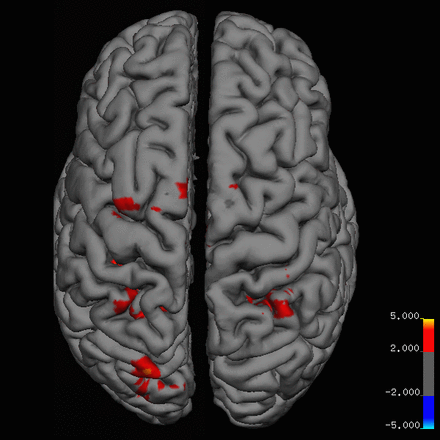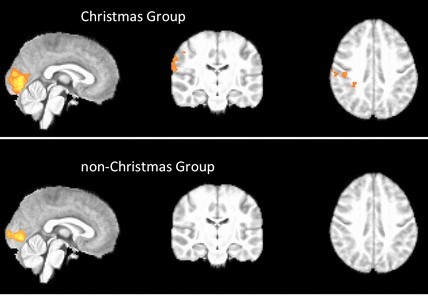'Christmas spirit' network found in the brain
M3 India Newsdesk Dec 25, 2021
A study published in the British Medical Journal tried to prove the connection of the Christmas spirit to brain activity. They attempted to localise the Christmas spirit in the human brain using functional magnetic resonance imaging (fMRI) exploring people's response to Christmas. This article explains the interesting findings from the study.
Key takeaways
- Significant clusters of increased BOLD activation in the sensory-motor cortex, the premotor and primary motor cortex, and the parietal lobe were found in scans of people who celebrate Christmas.
- A circannual rhythm has evolved in humans for the reoccurring event of Christmas. It is hormonally regulated and associated with activity in different brain areas.
The study
Scientists have been curious about the connections of the “Christmas spirit” in the human body. They have been trying to deduce the biological mechanisms involved with behaviour. It is known that the cerebral cortex houses the centres for emotions and behavioural patterns.
As part of the study, functional brain scans optimised for detection of the blood oxygen level-dependent (BOLD) response were performed while participants viewed a series of images with Christmas themes interleaved with neutral images having similar characteristics but containing nothing that symbolises Christmas.

After scanning, participants answered a questionnaire about their Christmas traditions and the associations they have with Christmas. The participants were from two groups, one that followed the Christmas tradition and the one that did not follow any traditions related to Christmas.
Brain activation maps from scanning were analysed for Christmas related activation in the 'Christmas' and 'non-Christmas' groups individually. Subsequently, differences between the two groups were calculated to determine Christmas specific brain activation.
Significant clusters of increased BOLD activation in the sensory-motor cortex, the premotor and primary motor cortex, and the parietal lobule (inferior and superior) were found in scans of people who celebrate Christmas with positive associations, compared with scans in a group having no Christmas traditions and neutral associations. These cerebral areas have been associated with spirituality, somatic senses, and recognition of facial emotions among many other functions.
The study concluded that there is a 'Christmas spirit network' in the human brain comprising several cortical areas. This network had significantly higher activation in people for whom Christmas is an important traditional festival.

On the other hand, the biochemical and molecular biological mechanisms that underlie the changes around Christmas in the brain are not well-established yet. Nevertheless, there seems to be a link to the biological rhythm, which prepares the brain for reoccurring events.
Christmas circannual rhythm
It has been hypothesised that a circannual rhythm, i.e. a rhythm of annual periodicity, has evolved in humans for the reoccurring event of Christmas. It is hormonally regulated and associated with the activity in different brain areas, such as the parietal lobules. It is speculated that the Christmas circannual rhythm is a four-phased mechanism of:
- Organisation
- Hormone release and positive feedback
- Behaviour climax
- Subsequently negative feedback
During the organisation phase, a cluster of neurons in the hypothalamus labelled as the 'Christmas vivifying centre' is active. This cluster of neurons seems to be dormant for approximately 11 months of the year and becomes active around December. The activity of the Christmas vivifying centre is promoted by strong environmental cues, termed 'Zeitgeber'. These are:
- Visual cues such as candle lights and Christmas trees.
- Auditory cues such as Christmas carols and the sound of bells.
- Olfactory cues such as mulled claret, gingerbread, and cinnamon.
The accumulating perception of these cues leads to the occurrence of a very particular feeling of pleasantness and cosiness that occasionally is called 'Christmas feeling'. This is accompanied by an increased inclination for interpersonal bonding and an increased tendency to participate in togetherness.
Molecular biological investigations found that the Christmas zeitgeber trigger hormonal responses, specifically the synthesis of Christmas-releasing factor (ChRF). ChRF activates different hypothetical target genes, such as SANTA (SEASONAL ACTIVATED NIKOLAUS TRANSCRIPTION FACTOR A) and ELF (ENHANCED LEBKUCHEN FEEDING), as well as the release of other hormones such as oxytocin.
It has been suggested that hormonal and gene activation responses escalate by positive feedback mechanisms, and climax at Christmas Eve or Christmas Day. This is represented externally by the exchange of Christmas gifts.
Due to the massive systemic disruption of homeostasis, the effects of negative feedback mechanisms start to surface when Christmas ends. These are mainly, but not exclusively, remorse of over-indulging in Christmas food, discontent with the received Christmas presents, and decreased levels of the social bonding hormone oxytocin. The negative feedback phase, however, rapidly ceases, potentially due to the activation of 'New Year’s Eve anticipation' mechanisms.
It is well accepted now that there are neurochemical roots to the behavioural patterns of people around the festival of Christmas. Yet, further research into this topic is necessary to identify the factors affecting one’s response to Christmas.
For example, responses to Christmas might change with development from a child, who primarily receives presents, to an adult, who primarily buys them. Subgroups subjected to receipt of tacky jumpers as their Christmas present might also have different responses in brain activity from those of subgroups who tend to receive more attractive gifts.
Understanding how the Christmas spirit works as a neurological network could provide insight into an interesting area of human neuropsychology and be a powerful tool in treating ailments such as Bah Humbug Syndrome.
Comparative studies of these patterns will also be imperative in studying other seasonal disturbances, related to, for example, Eid, Easter, Holi or Diwali. This study could therefore be an important first step in transcultural neuroscience and the associations humans have with their festive traditions.
Click here to see references
Disclaimer- The views and opinions expressed in this article are those of the author's and do not necessarily reflect the official policy or position of M3 India.
-
Exclusive Write-ups & Webinars by KOLs
-
Daily Quiz by specialty
-
Paid Market Research Surveys
-
Case discussions, News & Journals' summaries